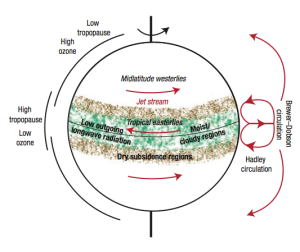The Hadley Circulation, responsible for the tropical humid band across the equator and the subtropical dry zones just poleward of it (e.g. Sahara Desert north of the Congo Rainforest), could be expanding [1]. The potential impact on society and the biosphere is difficult to ignore. Regions that are normally fertile and lying directly poleward of the subtropical dry zones (e.g. the Mediterranean) may in the future have far drier climates as the expansion pushes the dry zones poleward since the Hadley Circulation increases its width. This has the potential to disrupt agriculture, which could lead to rising food prices. The Mediterranean is more likely to be affected by such a shift as it lies just north of the Sahara Desert.
Hadley Circulation
The Hadley Circulation, a mass movement of air that begins near the equator where rising moist air cools and condenses with increasing altitude, releasing latent heat energy that forms and drives vigorous tropical storms akin to these regions. Positioned either side of the tropical regions are the subtropical dry zones. These arid regions result from the descending branch of the Hadley Circulation where descending air creates high-pressure regions that bring fine, dry weather (Figure 1).

Schematic showing the tropical moist regions with the dry zones and jet streams located poleward of this area. The high tropopause distinctly defines the extent of the Hadley Circulation (from Seidel et al., 2007).
The Hadley circulation may be expanding. Understanding what defines the width of the Hadley Circulation is vital to unearthing the root causes of its expansion as well as gauging the historically observed and projected expansion. The thin layer separating the lower atmosphere (known as the troposphere) from the upper atmosphere (known as the stratosphere) is called the tropopause and reaches its highest point over the tropics. This distinctly defines the Hadley Circulation. Another crucial way to determine the width is by measuring the distance between two permanent subtropical jet streams that reside poleward of the subtropical dry zones.
Studies have shown that the tropopause height has increased, accompanied by a poleward shift in the subtropical jets and associated storms tracks [1] and [4]. Some representative studies suggest a significant expansion of the Hadley Circulation of around 2 to 4.5 degrees latitude since 1979 [2]. Another study found that the rate of expansion was 0.55 degrees per decade from 1979 to 2009 [3]. There tends to be disagreement over the degree of the expansion however these studies (and references therein) show that a qualitative shift over the last 30 years.
Causes
The root causes are both largely unknown and complex. Greenhouse gas-induced global warming could be the main cause. With regards to the height of the tropopause, increasing CO2 levels warm the troposphere through absorption of longwave radiation, and cool the stratosphere via longwave CO2 radiative cooling. This has the net effect of raising the tropopause and consequently growing the size of the Hadley circulation. The subtropical jets and associated mid-latitude cyclones also shift poleward due to CO2 effects [4]. Stratospheric ozone depletion, the main cause of the ozone hole over Antarctica, has been shown to raise the tropopause in the Southern Hemisphere since there is lack of ozone to absorb short wave radiation which then cools the stratosphere [5].
There are still many unanswered questions regarding the mechanism behind the expansion and the spatial and temporal aspects of the expansion. In particular, the regional and seasonal dependence of the widening has been largely unexplored. Also many of the models used to give projected widening of the Hadley Circulation have very high climate sensitivity [6] so this must be taken into account when predicting the potential impacts of any shift in dry and wet zones. There is also a lack of investigation into the causes of the expansion in relation to changes in the El Nino Southern Oscillation, as well as the role of ocean currents in transporting heat from the lower latitudes to the higher latitudes.
Future
The widening of the Hadley circulations could have even more implications for the composition of the atmosphere as transport of trace gases are altered, as well changes in ocean currents which can have consequences for marine life and other biogeochemical cycles that could be irreversible [1]. If the uncertainties in the expansion of the tropical zone are not dealt with promptly and our mitigation of climate change too slow, then the next few generations growing up in the Mediterranean may one day wake up to a desert on their doorstep while the camels of the Sahara welcome the flora and fauna of an extended Congo.
[1] Seidel, D., Fu, Q., RanDel, W., & ReichleR, T. (2007). Widening of the tropical belt in a changing climate. Nature Geoscience, 21–24. doi:10.1038/ngeo.2007.38
[2] Hu, Y., & Fu, Q. (2007). Observed poleward expansion of the Hadley circulation since 1979. Atmospheric Chemistry and Physics, 7(19), 5229–5236. doi:10.5194/acp-7-5229-2007
[3] Nguyen, H., Evans, a., Lucas, C., Smith, I., & Timbal, B. (2013). The Hadley Circulation in Reanalyses: Climatology, Variability, and Change. Journal of Climate, 26(10), 3357–3376. doi:10.1175/JCLI-D-12-00224.1
[4] Yin, J. H. (2005). A consistent poleward shift of the storm tracks in simulations of 21st century climate. Geophysical Research Letters, 32(18), L18701. doi:10.1029/2005GL023684
[5] Polvani, L. M., Waugh, D. W., Correa, G. J. P., & Son, S.-W. (2011). Stratospheric Ozone Depletion: The Main Driver of Twentieth-Century Atmospheric Circulation Changes in the Southern Hemisphere. Journal of Climate, 24(3), 795–812. doi:10.1175/2010JCLI3772.1
[6] Bender, F. a-M., Ramanathan, V., & Tselioudis, G. (2011). Changes in extratropical storm track cloudiness 1983–2008: observational support for a poleward shift. Climate Dynamics, 38(9-10), 2037–2053. doi:10.1007/s00382-011-1065-6#








